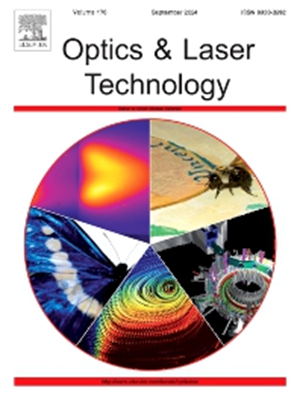Turbulence-tolerant 12-bit/symbol OAM shift keying free space optical communication using a two-stage neural network
IF 5
2区 物理与天体物理
Q1 OPTICS
引用次数: 0
Abstract
Orbital angular momentum-shift keying free space optical (OAM-SK FSO) communication inherently suffers from disturbances in atmospheric turbulence (AT), which significantly degrades the communication performance. In this manuscript, we demonstrate a turbulence-tolerant 12 bit/symbol OAM-SK FSO communication system using a two-stage neural network, which features a modified U-Net for compensating OAM modes, and a two-step convolutional neural network for decoding. In simulation, the full capability (accuracy ) of the proposed model in recognizing all types of OAM modes disrupted by different levels of AT is demonstrated. After transfer learning on experiment data, the model still exhibits good generalization in the practical system. The transmission of a 12,000-depth pseudo-random binary sequence encoded by 1000 12-bit symbols is displayed in a mock-up experiment, and bit error rates of , , under weak, moderate and strong AT are observed respectively. This study provides a new, to the best of our knowledge, platform for high-capacity, robust FSO communication.
采用两级神经网络的耐湍流12位/符号OAM移位键控自由空间光通信
轨道角动量偏移键控自由空间光学(OAM-SK FSO)通信本身会受到大气湍流(AT)的干扰,从而显著降低通信性能。在本手稿中,我们展示了一种耐湍流的 12 比特/符号 OAM-SK FSO 通信系统,该系统采用了两级神经网络,包括用于补偿 OAM 模式的改进型 U-Net 和用于解码的两级卷积神经网络。在仿真中,证明了所提出的模型完全有能力(准确率达 98.87%)识别被不同程度的 AT 干扰的所有类型的 OAM 模式。在对实验数据进行迁移学习后,该模型在实际系统中仍表现出良好的泛化能力。在模拟实验中显示了由 1000 个 12 位符号编码的 12000 深度伪随机二进制序列的传输情况,并观察到在弱 AT、中 AT 和强 AT 下误码率分别为 2.50×10-4、4.17×10-4 和 4.75×10-3。据我们所知,这项研究为大容量、稳健的 FSO 通信提供了一个新平台。
本文章由计算机程序翻译,如有差异,请以英文原文为准。
求助全文
约1分钟内获得全文
求助全文
来源期刊
CiteScore
8.50
自引率
10.00%
发文量
1060
审稿时长
3.4 months
期刊介绍:
Optics & Laser Technology aims to provide a vehicle for the publication of a broad range of high quality research and review papers in those fields of scientific and engineering research appertaining to the development and application of the technology of optics and lasers. Papers describing original work in these areas are submitted to rigorous refereeing prior to acceptance for publication.
The scope of Optics & Laser Technology encompasses, but is not restricted to, the following areas:
•development in all types of lasers
•developments in optoelectronic devices and photonics
•developments in new photonics and optical concepts
•developments in conventional optics, optical instruments and components
•techniques of optical metrology, including interferometry and optical fibre sensors
•LIDAR and other non-contact optical measurement techniques, including optical methods in heat and fluid flow
•applications of lasers to materials processing, optical NDT display (including holography) and optical communication
•research and development in the field of laser safety including studies of hazards resulting from the applications of lasers (laser safety, hazards of laser fume)
•developments in optical computing and optical information processing
•developments in new optical materials
•developments in new optical characterization methods and techniques
•developments in quantum optics
•developments in light assisted micro and nanofabrication methods and techniques
•developments in nanophotonics and biophotonics
•developments in imaging processing and systems

 求助内容:
求助内容: 应助结果提醒方式:
应助结果提醒方式:


